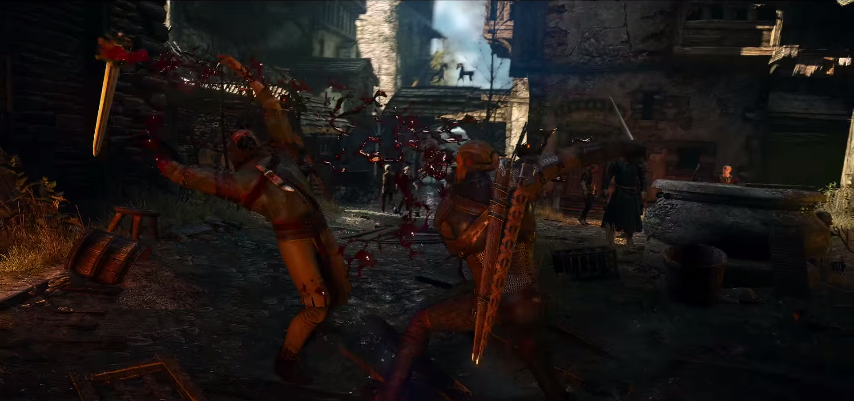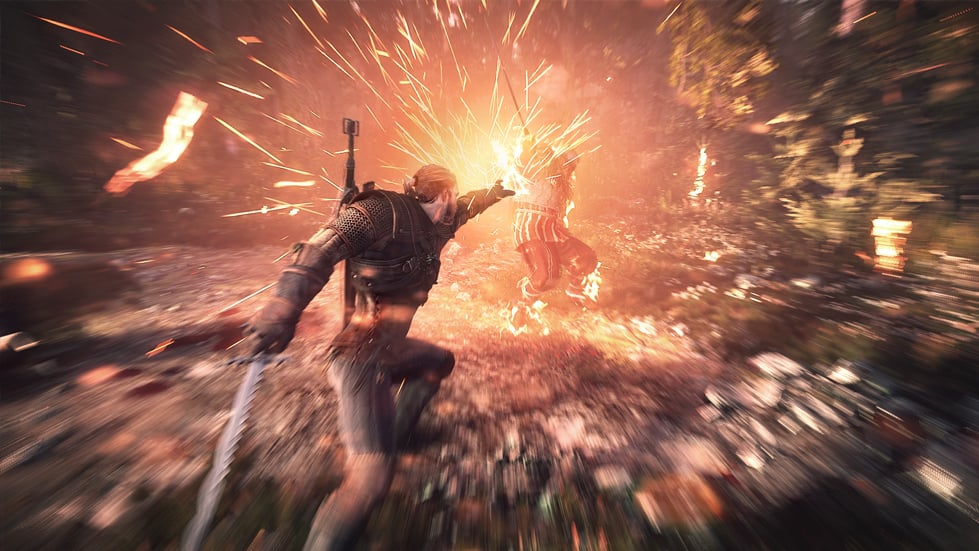Combat in The Witcher 3: The Wild Hunt is covered on this page, ranging from basic combat mechanics to advanced sign usage, alchemy and so on. In The Witcher 3:Wild Hunt, you'll be faced against all types of Enemies, from big monsters such as Fiends, to human bandits, each with their own strengths to look out for and weaknesses to exploit. Specific combat information, such as enemy Potion weaknesses, can be found in-game in the Bestiary.
Combat in the game starts when you approach a hostile enemy. It may also start in peaceful towns and cities if a guard catches you stealing or if you hit a peaceful NPC. It will not stop until you have defeated all hostiles in the area or you have run far enough away from the area.
The Witcher 3 Combat
The Witcher 3 HUD
Courtesy of 20WaystoeataSandwich
Attacking in the Witcher 3
Geralt has two main types of weapons available to him during combat. - Steel Weapons and Silver Weapons. Silver Weapons are most effective against Monsters and are relatively ineffective against humanoids and animals, while the reverse is true for Steel Weapons. Enemies with pure red health bars are susceptible to Steel Weapons while those with silver and red health bars are susceptible to Silver Swords. For ranged combat situations, Geralt has access to Crossbows. They are significantly weaker than melee weapons but each Bolt has its own unique effect. During underwater combat, Geralt is limited to only using his crossbow.
The Witcher 3 Alchemy
Geralt has access to many useful consumables that can help him out in combat through Alchemy. They are Oils, Potions, Decoctions, and Bombs.
Oils are a way of boosting sword damage. Once applied to the appropriate equipped sword, you gain a damage boost to a certain type of enemy (i.e. applying the Beast Oil to a blade boost your damage against Beast-type enemies). Each oil has three versions of different quality - Standard, Enhanced, and Superior - with each tier of quality increasing the oil's damage multiplier and number of charges.
Potions and Decoctions are consumables that can grant Geralt a variety of different effects when drank. Drinking any Potion/Decoction increases Geralt's Toxicity and exceeding the Toxicity threshold will cause Geralt to take small amounts of damage over time. Toxicity from Potions slowly decreases on it's own over time, but that of Decoctions only goes away after the effects of the Decoction have expired. You will be unable to drink any more Potions/Decoctions if the consumable you are about to take would take Toxicity to over your current maximum.
Bombs are another useful tool you can make through Alchemy. As expected from their name, Bombs are throwable consumables that deal damage or apply certain effects to Enemies they are thrown at. These effects range from preventing enemies from transforming, to applying certain status effects on them, to lowering their defense.
The Witcher 3 Signs
Signs are the 'magic spells' available to all Witchers. As Geralt, you have access to 5 different signs:
- Aard: A directed blast of telekinetic energy that staggers opponents, leaving them open for a subsequent attack.
- Igni: A directed fiery blast that damages enemies. Damage scales with Sign intensity.
- Yrden: Magic trap that slows enemies who enter its area of effect.
- Quen: Protective shield that lasts until it has absorbed damage totaling 5% of maximum Vitality.
- Axii: Charms an opponent's mind, temporarily eliminating him from combat.
Using a Sign requires your whole Stamina bar. Signs scale off of Sign Intensity, but the effect it has differs for each sign. Besides being used in combat, these signs have out of combat usages, including breaking down fragile walls with Aard and lighting fires with Igni.
Mounted Combat in the Witcher 3
Roach is the name given to all mares that Geralt has owned. In the Witcher 3, she is one of Geralt's main ways of getting around the Continent. Roach has three speeds - walking, cantering, and galloping - and has her own Stamina bar. It is consumed while she is galloping, but not walking or cantering. If she runs out of Stamina while galloping, she goes back to cantering and can be made to gallop again by activating the button once more when her Stamina recharges.
While on Roach, you are able to jump over obstacles and fight monsters. You, however, are only able to swing your sword and shoot your crossbow while on horseback and are unable to use your Bombs and Signs (with the exception of Axii). There are special combat rules while riding Roach - if you manage to hit an opponent while galloping at full speed, the blow will usually be a critical hit and there's a chance that the hit will insta-kill the enemy. In addition, being in close proximity to hostiles and getting hit on horseback increases Roach's fear meter. Reaching the cap will result in Roach panicking and flinging you onto the ground, giving Enemies a few free hits on you. Using Axii while on Roach will decrease her fear by a small amount.
The Witcher 3 Combat Features
Combat in The Witcher: Poetry in motion
The new combat system in The Witcher 3 has been redesigned in order to combine traditional RPG elements with the speed and precision of a dedicated fighting game. Smooth and responsive, the system gives players full control of Geralt’s blade, challenging them to match their reflexes against those of a master swordsman. They will feel what it’s like to be a true witcher, the ultimate monster slayer. Players familiar with the combat mechanics in The Witcher 2 will find that every aspect of the skirmish is now approached with a fresh perspective, expanded and polished to shine, while still retaining the spirit known from the previous game.
Players can:
- unlock new blocking moves, attacks and evasions,
- discover ways to stun foes, ignite them and control their minds with enhanced witcher Signs,
- poison their blades, set traps and blow their enemies to bits with bombs.
When combined, these attacks kill more efficiently, challenging players to experiment, think creatively and devise new tactics.
Dynamic, fluid and rooted in traditional RPG systems
Through a series of new features, players can merge their skills with Geralt’s developing combat acumen:
- The number of attacks, parries and other combat moves has been greatly increased and rendered fluid with 96 new action sequences (compared to 20 in The Witcher 2).
- Three different sets of movement animations let Geralt adjust his stance to match the dangers he faces.
- Players enjoy complete control of Geralt in combat as there are no QTEs or scripted timing attacks.
- A new camera system, superior even to that utilized in the Xbox 360 version of The Witcher 2, shows fights in all their glory while keeping the focus on what the player needs to see.
- Geralt’s character development visibly affects his behavior in combat: obtaining a Swordsman skill might increase attack animation speed, while a Mage ability could turn the Igni Sign into a torrent of blue flame.
- Geralt has two distinct moves at his disposal to avoid harm: Rolling & Backstepping. Key to mastering the game's combat is realizing when each of these is best used. Rolling, a slightly slower action, is utilized mainly for repositioning - it grants few invulnerability frames and covers a longer distance but can be easily interrupted. Backstepping on the other hand covers much less ground but whilst it's being performed Geralt will take no damage from enemy blows. During the animation any damage will be nulled so it's of the essence to try and use it at the best possible moment. After the invulnerability frames have expired any damage dealt by enemies will be received in full.
Enemy Level Ranges
Enemies in The Witcher 3: Wild Hunt are divided into three categories, or ranges:
- White: The enemy is weak compared to the player and should pose no problem. Still, be weary of mobs or even small groups while playing on "Death March!" since such situations can prove treacherous.
- Green: The enemy is close to your level - keep in mind that you since are alone whilst facing a group of equally strong, or stronger enemies the battle might prove a challenge.
- Red/Red Skull: The enemy is of much higher level (6+) and should not be attempted. Chances of survival are very slim HOWEVER victory is not impossible.
Use your brain, they’ll use theirs
Combat is realistic, dynamic and rewarding, featuring smart enemies and living battlefields:
- Each of the 80 monsters Geralt can encounter has its own habitat, strengths and weaknesses.
- Improved crowd AI means enemies communicate with each other in combat, coordinating their efforts to surround Geralt or deploy combo attacks.
- Monsters and other foes do not scale with the player: beasts that crush players with a single swipe at the outset become sword fodder by the game’s end.
- Enemy morale shapes their actions: opponents flee or fight more cautiously when scared, attack recklessly when desperate, and beg for mercy on their knees when defeat is inevitable.
- The environment is a factor in combat, and Geralt can use it to his advantage: he might destroy a hive to unleash an angry swarm of hornets on a foe, or cast the Aard Sign to bury a group of thugs beneath a toppled stack of barrels.
 Anonymous
Anonymous






How to make Gerald block an attack?
0
+10
-1